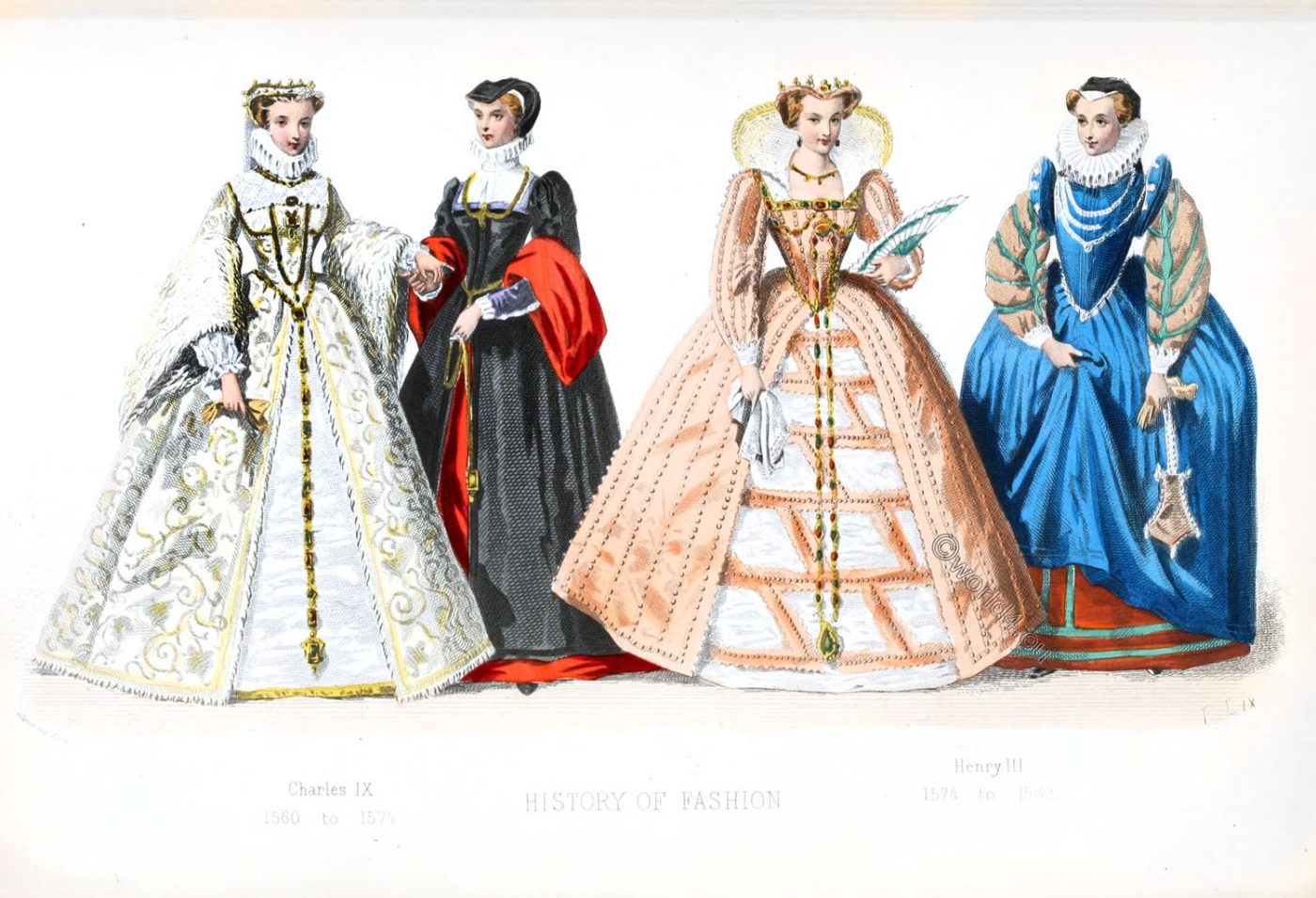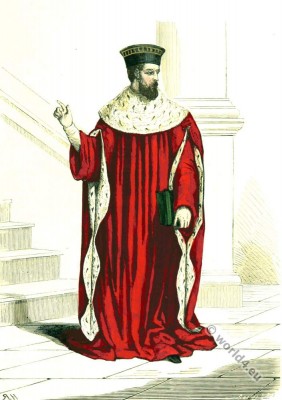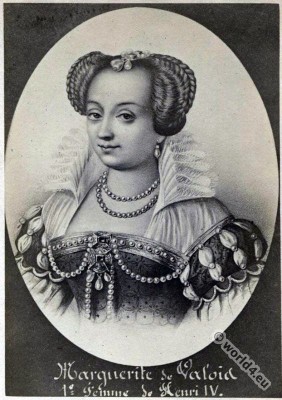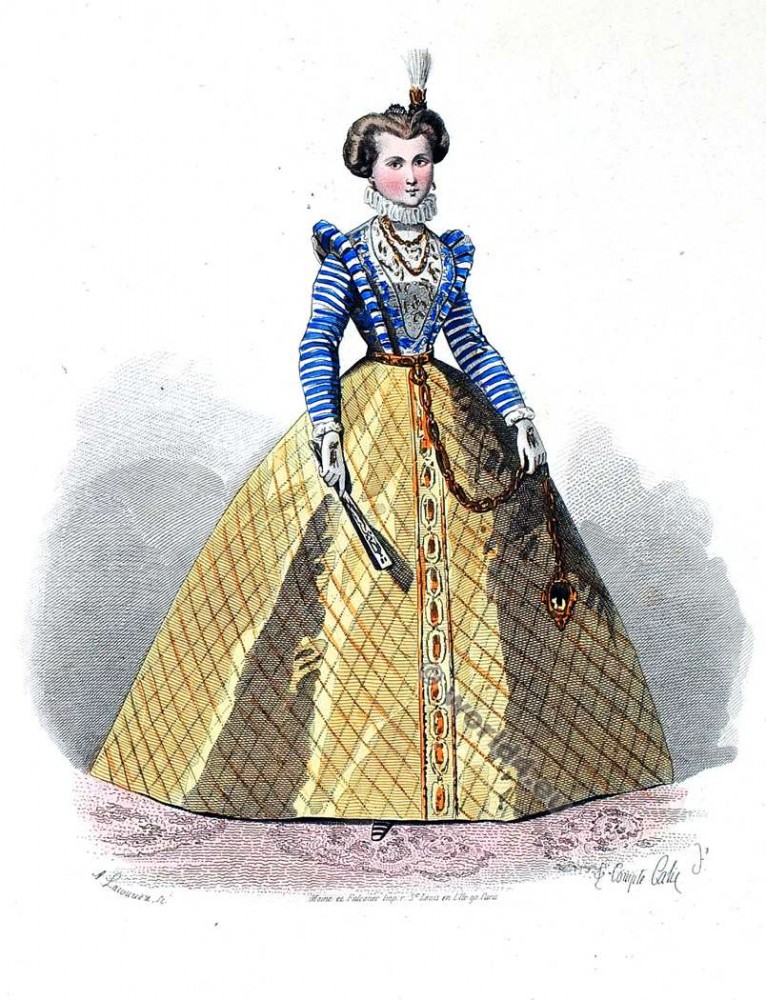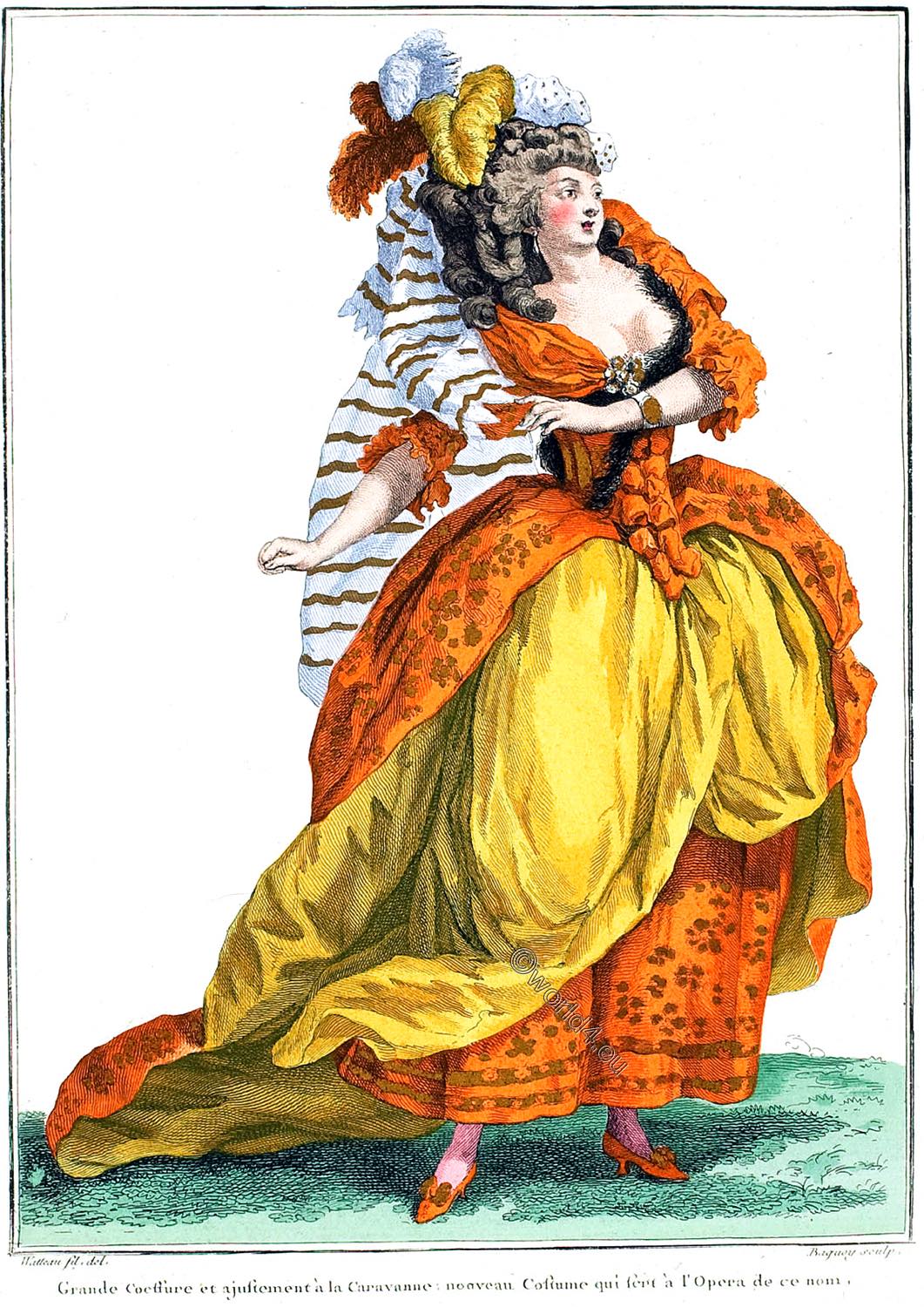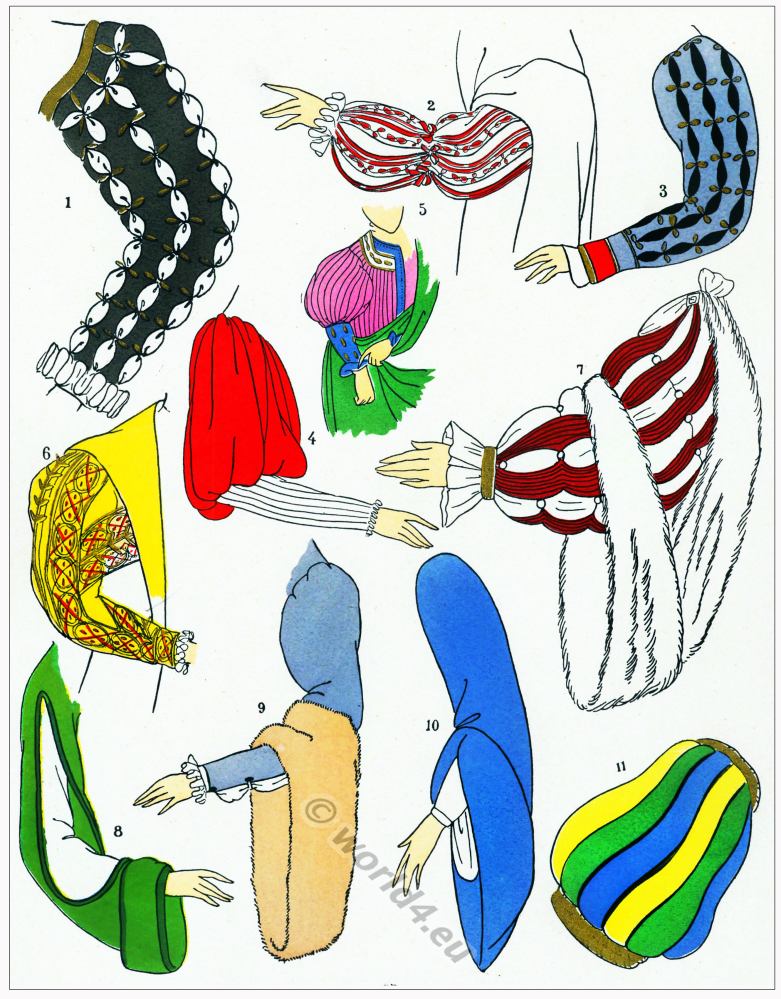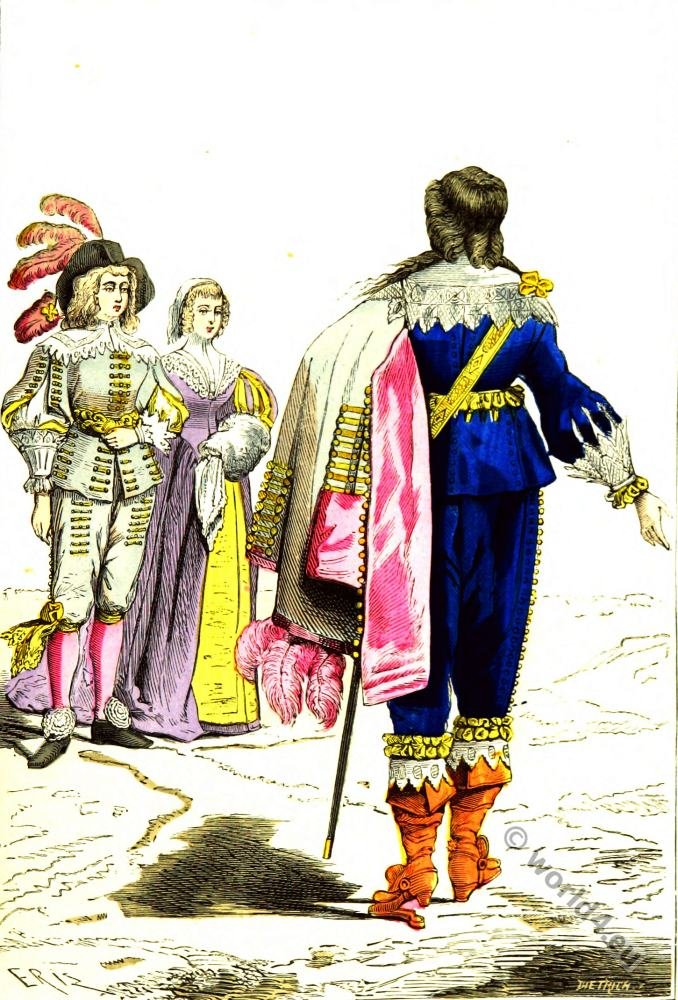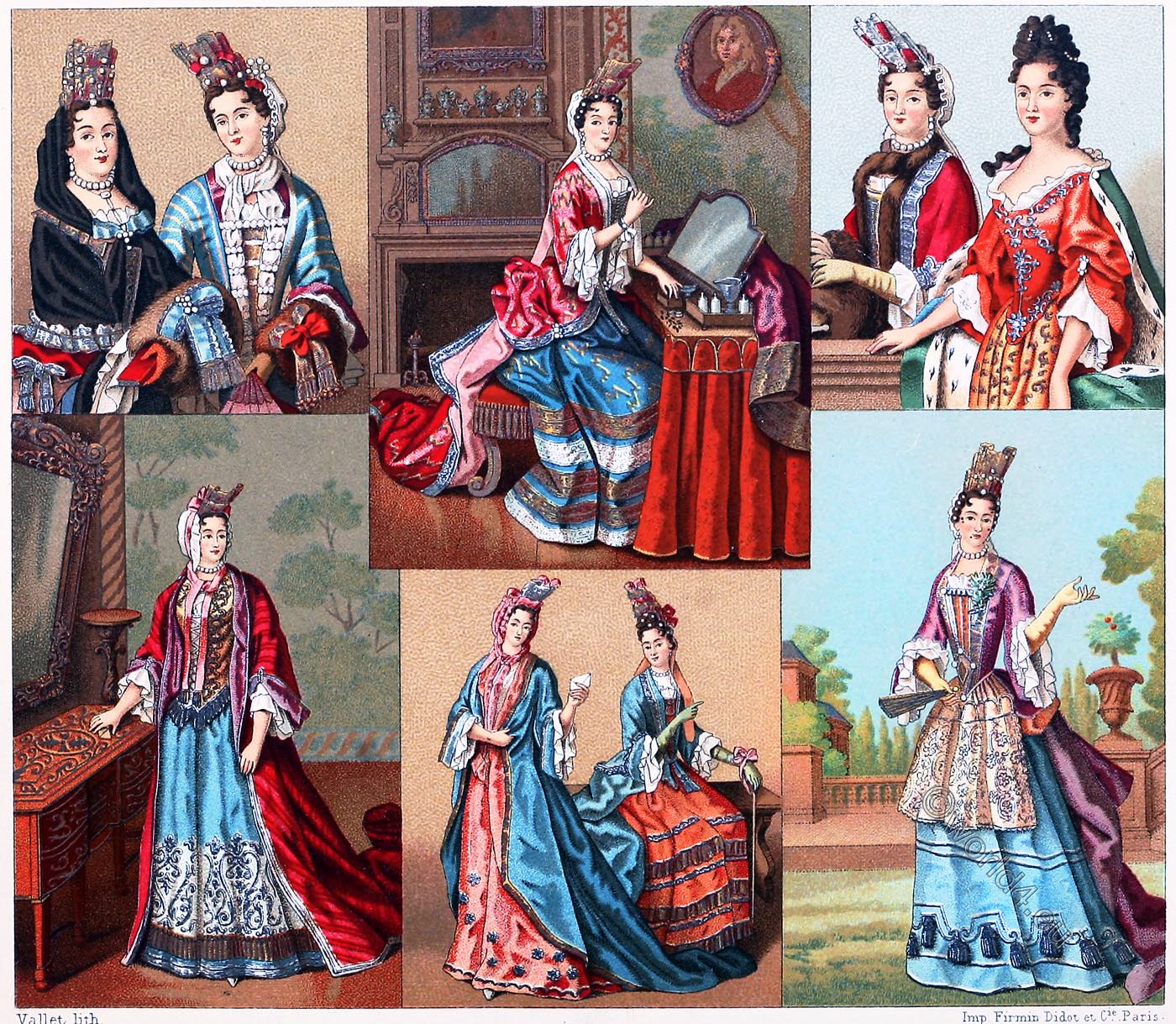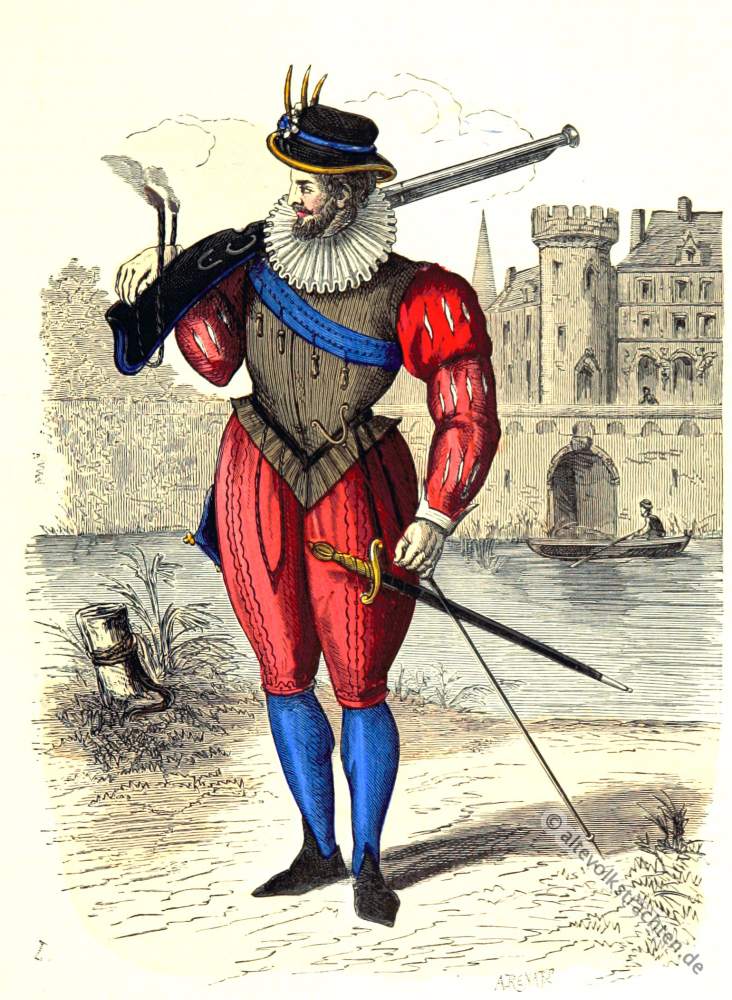Fashion in the Reign of Henri III. 1574 to 1589.
Content:
Opposition to the laws of King Henri III. on dress — The wife of President N .— How both sexes evaded the edicts – Gowns from Milan — Mixture of masculine and feminine fashions —Rage for perfumes — Recognition of rank is demanded — Costumes worn at Cognac by Marguerite de Valois in presence of the Polish, ambassadors, and her costume at Blois — Brantôme’s opinion — Pointed bodices, puffed out sleeves, and “bourrelets” — Remarks on hair — Ridiculous dress of men — Poucet, the preacher — Satirical lines on Joyeuse — Witty remark of Pierre de I’Estoile — Starch used by Henri III. — Cushions.
Fashion in the 16th century. The Spanish court dress.
Simplicity seems to have been the motto of Charles IX., as we have seen by the sumptuary laws he issued. The ideal of his successor Henri III. was, on the contrary, splendour of every kind. His courtiers indulged in the wildest extravagances, in imitation of their sovereign, whose life was passed in continual diversions and magnificent fetes, and who set the example of extravagance in dress, and yet constantly issued fresh edicts against luxury.

Opposition to the laws of King Henri III. on dress
Henri de Valois cannot be said to have preached by example, for his conduct was in flagrant contradiction of his precepts. A strong opposition sprang at once into existence when he issued a sumptuary law forbidding his great nobles to wear garments of gold or silver cloth.
It is told of the queen, that she was, on one occasion, in a linendraper’s shop, and seeing a lady dressed with great elegance, she asked, “And who are you?” The lady, without looking at the speaker, replied that she was the wife of President N-.
“In good truth, Madame la Presidente,” observed the queen, “you are very smart for a woman of your rank.” “At any rate, I am not smart at your expense,” returned the lady; and then suddenly recognising the queen, she threw herself at her feet.
Louise de Lorraine gently remonstrated with her upon her extravagance; she herself having little taste for dress or display.
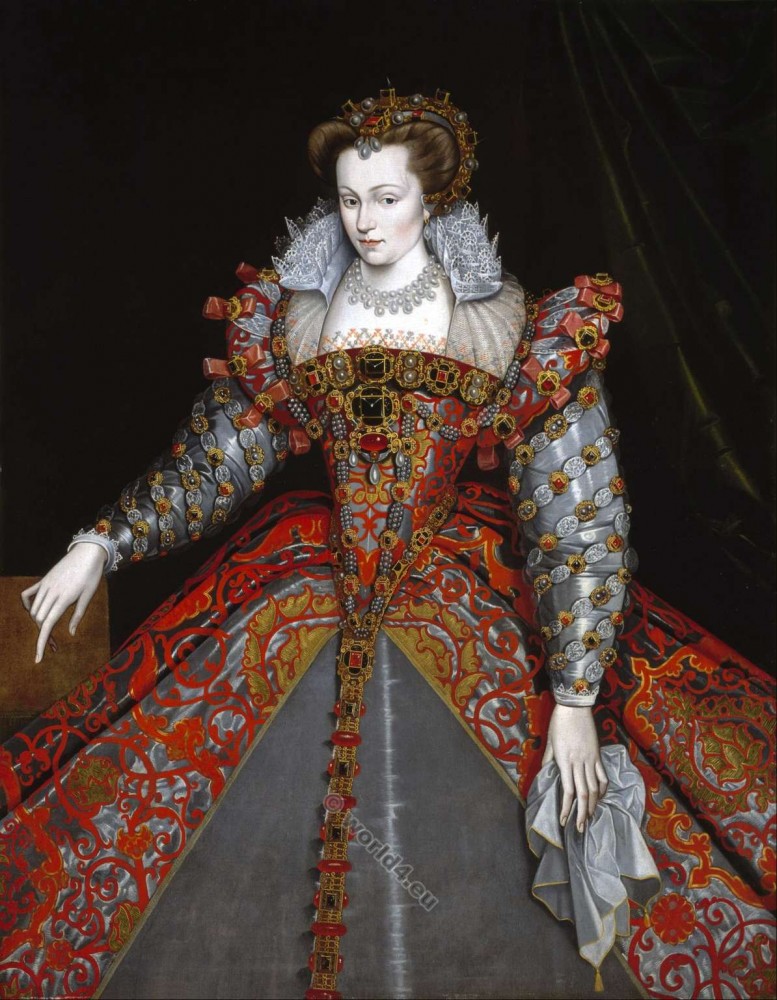


Alexandre-Édouard, Duke of Anjou, also known as Henri de Valois was 1573-1574 as Henryk Walezy King of Poland-Lithuania, from 1574 until his death in 1589 King of France and last king of the House of Valois.
How both sexes evaded the edicts.
Those subjects of the king who felt offended by his edicts did not think proper to visit the city in garments of serge, like Louise de Lorraine; they had recourse to another expedient, and evaded the royal commands by arraying their valets in the splendid clothes forbidden to themselves. The lacqueys of the great nobles were thus attired in heavily embroidered liveries of silk. Every one, on seeing a servant with all the seams of his coat embroidered in gold, conceived a high idea of the noble personage his master, and ot that master’s wealth. Liveries served as an advertisement of nobility and a demonstration of pride.
Women, however, acted on a different plan. Far from dressing up their maids in pearls and diamonds, a proceeding by which they might have created rivals to their own beauty, they discovered another way of evading the law. They had recourse to subterfuge.
Since brocades were forbidden, they sent to Milan for gowns which, without a thread of gold or silver in them, cost, generally speaking, 500 crowns each; and the Italian manufacturers gained by all that our own lost.
Gowns from Milan
Five hundred crowns for the material of a dress! This was a round sum. Five hundred more were spent by French ladies on adjuncts and ornaments, on fringes, braidings, twists, and “cannetilles;” and they were delighted with the splendour they had attained without the help of either gold or silver. Their love for the beautiful was satisfied; the Milan gowns were quite equal to brocade!
What right had Henri de Valois, asked the belles of the period, what right had he who “starched his wife’s collars and curled her hair,” according to malicious reports, to show such severity concerning other women’s dress?
Did not he himself wear a velvet hat, with a plume and an aigrette of diamonds? Surely this head-dress had not a martial air? Had he not an invincible propensity for effeminacy in everything? Had he not deeply studied the contents of the queen’s wardrobe? and was he not more learned than all her women on every matter of feminine attire?
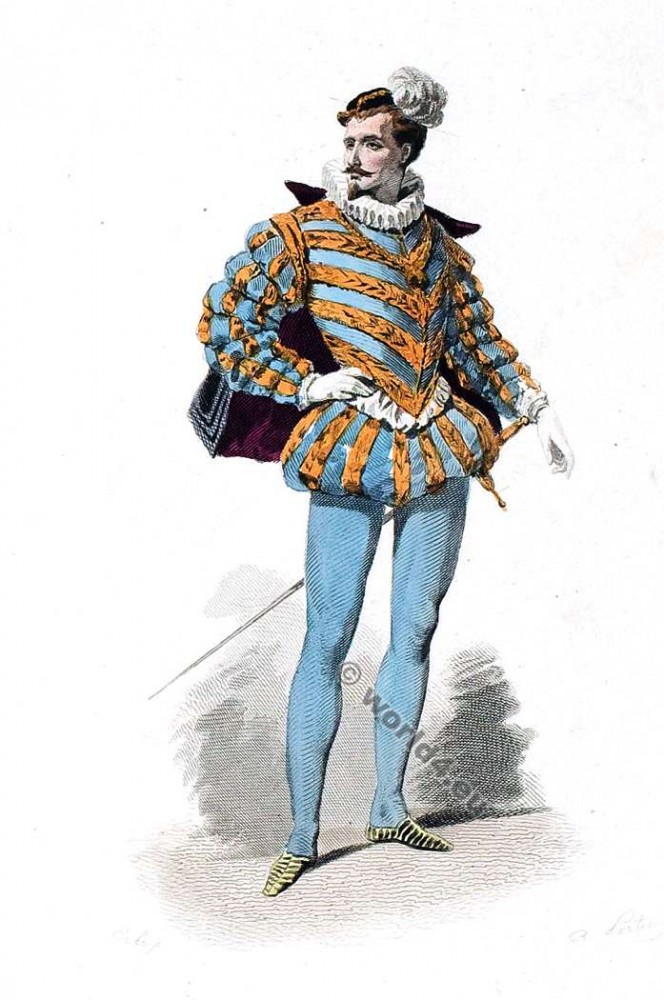
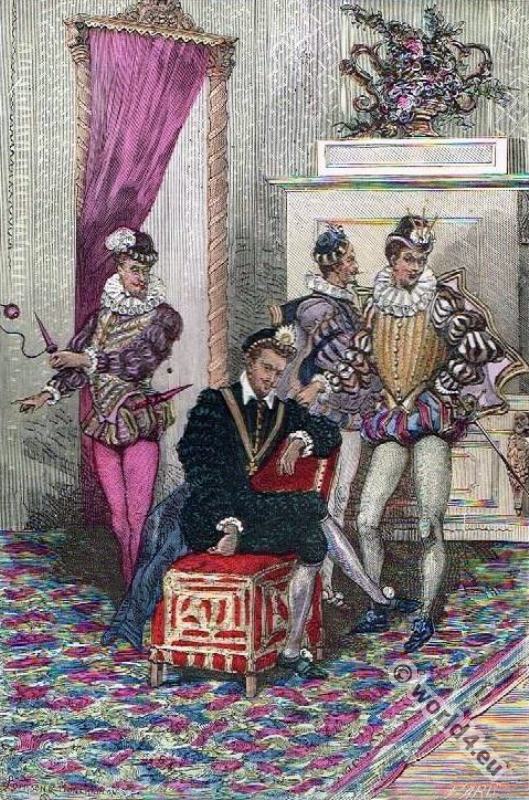
Mixture of masculine and feminine fashions
And worse than this! Immediately on his return from Poland he eagerly adopted the fashion of paint and violet powder, that women had initiated at the end of the reign of Charles IX. A sort of rivalry sprang up under his auspices between the great nobles, who made him their model, and the ladies of the court. Not satisfied with his plumed cap, identical with the feminine coif or “escoffion,” he was perfumed with amber from head to foot. Never had such a thing been known in France.
Rage for perfumes
The Italians at the court of Catherine de Médicis had introduced a refined taste in perfumes. Nicolas de Montau, in his “Miroir des François,” reproved ladies for “making use of every perfume — cordial, civet, musk, ambergris, and other precious aromatic substances— for perfuming their dresses and linen, nay, their whole bodies.” The fashion spread, even among the bourgeois class.
Everything was perfumed, garments, hair, gloves, and shoes; cavities were contrived in rings, bracelets, and necklaces to contain scent. Fans, which were used by young dandies in ruffs and ringlets, as well as by ladies, exhaled an unmistakable odour as they were gently fluttered in the breeze. The sexes vied with each other in the use of perfumes. Every lady at the court wore silk knitted gloves and scented gloves; and it has been asserted that the good Jeanne d’Albret, mother of Henri IV., was poisoned by gloves sent from Italy.
See also: The Art of Perfumery in Italy and in France.
The dress of women consisted of a whalebone bodice, very tight to the waist, with large leg-of-mutton sleeves. “When the princesses or duchesses,” says Montaigne, “had not waleboned bodices, they tightened their waists with wooden splints; for, above all, it was necessary to astonish the world by a slender waist.” They usually wore two gowns, one over the other, either of the same colour with variegated trimmings, or of different colours.
Flowered garters were worn. The mask or loup, worn when walking, as in the reign of Charles IX, was not attached by strings, but held by a glass button between the teeth. A round mirror, with a handle, hung at the waist, and afforded means of ascertaining the state of the toilet at any moment. This fashion had existed under Charles IX.
The head-tire most usually worn was a toque with or without an aigrette, “à bourrelet,” or a small high-crowned hat, of which the material was, as it were, crumpled up.
Many women still wore the old-fashioned hoods; for young unmarried ladies they were made of velvet with long falling lappet at the back, with a high “touret” and ear-pieces, sometimes ornamented with gold, and called “coquilles” (shells). The hoods worn by bourgeoises were made of cloth, and with a square “tournette.” Difference of rank was still indicated by difference of dress, and was destined so to continue for several centuries to come.
The heart-shaped head-dress of the fourteenth and fifteenth centuries again made its appearance, but the heart was now constructed of the hair itself, instead of a piece of stuff as formerly. Complaints began to be made by great ladies that certain bourgeoises were so bold as to wear velvet and gold ornaments. Petitions from the nobles at the États de Blois *), 1588, set forth “that the wives of advocates, procureurs and treasurers, bourgeoises, and other ignoble women should not be allowed to wear velvet hoods.”
*) As the Estates General (fr. États généraux) is called in France the first time in 1302 by King Philip IV. constituted meeting of representatives of the three estates. These consisted of clergy, nobility and the Third Estate (fr. Tiers État). Each of these representatives had approximately 300 delegates. The dress code of the Estates General foresaw that the representatives of the nobility in pompous robes with plumed hat and sword, the representatives of the clergy had to appear in make purple robes and the bourgeois deputies of the Third Estate in plain black.
What would be the feelings of women of the present day, if any one ventured to forbid them any sort of head-dress! Can we picture to ourselves the wives of lawyers or merchants prevented from dressing as they please!
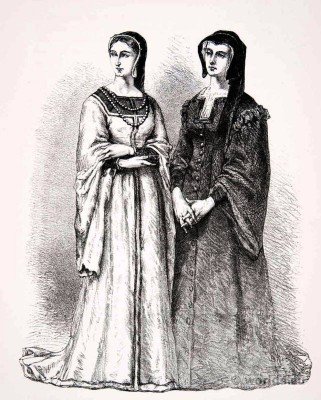
Costumes worn at Cognac by Marguerite de Valois.
The ideal costume of the reign of Henri III. was realized in the dress worn by Marguerite de Valois at Cognac, on the occasion of her visit to that town at the commencement of her journey through France, and before her marriage with the King of Navarre.
She “put on her handsomest and most superb apparel, that she wore at court on occasions of the greatest magnificence.” She desired to dazzle the inhabitants of Cognac. “Besides,” said she, “extravagance is with me a family failing.” Marguerite was continually promoting fetes and tournaments, where splendid dress was combined with sparkling wit.
Let us hear what Pierre de Bourdeilles, Abbot and Lord of Brantôme, says on the subject:- “Marguerite appeared, superbly attired in a gown of cloth of silver and colombine colour ‘à la Boulonnaise,’ with hanging sleeves; a magnificent head-dress and a white veil, neither too large nor too small. All this was accompanied by so sweet and gracious a majesty, that she seemed more like a goddess from heaven than a queen of the earth.”
The queen said to her:- ‘My child, you look very well!’
And she answered:— ‘Madame, here I wear out the gowns I brought with me from court, because when I return thither, I shall not take them with me. I shall take only scissors, and materials, in order to set myself up again in whatever may be the reigning fashion.’
The queen replied:- ‘Why do you talk thus? since you know that it is yourself who invents all the pretty fashions we follow; and wherever you may go, the court will copy you, and not you the court.’
Catherine de Médicis, who always feared that the scepter of government might be wrested from her, endeavoured by these words to make her daughter desirous only of the scepter of Fashion.
And in truth whatever Marguerite de Valois wore became at once the rage among her sex. The charm of her beauty and her still greater charm of manner invested her with supreme rule over all the finery of the great court ladies. On one occasion she would appear in a white satin gown, adorned with tinsel, with a touch of crimson here and there, and a salmon-coloured crape or Roman gauze veil thrown carelessly over her head; on another, her orange and black gown and large veil would elicit general admiration; or she would excite the most ecstatic delight by inventing a perfectly original costume.
On the arrival of the Polish ambassadors who brought the news of the election of the Duke d’Alençon (afterwards Henri III.) to the throne of Poland, and were delegated by the nation to receive the oath of their new king.
Marguerite de Valois wore a gown of Spanish crimson velvet richly trimmed with gold, and a toque of the same material adorned with jewels and bright feathers. Thus attired, she looked so divinely beautiful that she had her portrait painted in that costume. Marguerite had resolved not to be outdone by the Polish envoys, who were attired in the semi-Oriental, semi-fantastic style, with great plumes and widespread eagles’ wings.
Her abundant hair required no artificial aid. On Easter Day at Blois, at the procession, she wore large pearl stars in her hair, and a gown of cloth of gold of Eastern manufacture, which had been given by the Grand Turk to the French ambassador, who in his turn had presented it to Marguerite. It was so heavily weighted with jewels, that only so strong a woman as she was could have carried the weight of it.

Pointed bodices, puffed out sleeves, and “bourrelets”
But notwithstanding Brantôme’s approbation (Pierre de Bourdeille, seigneur de Brantôme, c. 1540-1614. French writer). Marguerite de Valois is justly accused, by an eminent archaeologist, of having degraded rather than improved the fashions of her time. He asserts that her taste was not good.
Marguerite de Valois was certainly mistaken in lengthening the waists of dresses to a preposterous degree; in inventing sleeves puffed out at the top and tight at the wrist; and, finally, in replacing vertugadins by masses of padding on the hips, which made the skirt look like a big drum, and took away all lightness and elegance from the figure.
Marguerite de Valois had magnificent black hair, but, setting little value on this gift of nature, she usually covered it with false hair of a light shade. She is said to have selected fair-haired pages, whose long locks were occasionally shorn for her benefit. Much the same custom prevails at the present day, the hairmarket being supplied by peasant girls.
According to the François Roger de Gaignières collection in the National Library, which consists of thousands of drawings and engravings, the ladies at the court of Henri III. wore sleeves of enormous size, the whole dress, bodice, and skirt being of the same material.
Servants of the period wore bodices with busks, and carried keys in the right hand and a basket over the left arm. The costume was grave, and yet not without elegance. But however full of absurdities were feminine fashions under Henri III., those for men far exceeded them; their whims and eccentricities were unbounded.
The enormous starched collars that rose from a fine lady’s shoulders, and made a sort of hollow niche behind her head, could not long retain their freshness, however carefully worn, and the padded “busts,” somewhat like a piece of armour, must have greatly impeded all natural movement; while the goffered ruff, separating the head from the shoulders, was far from graceful, notwithstanding the “bichons,” or rolls of hair, on the temples. All these constituted an affected and ungraceful costume, and the wearers were called “poupins” by the ill-natured wits of the time.
Poucet, the preacher. Satirical lines on Joyeuse
The courtiers and favorites of Henri III. imitated the court ladies, not only by wearing pearl necklaces, earrings, and rings of gold, silver, precious stones, enamel, &c., but also wore their “bourets” of velvet, and their “bichons” or rolled hair. They were “fraisés et frisés,” that is, they wore both ruffs and curls. Their pourpoints were open, so as to display the point lace, at that time recently imported from Venice.
The fans of these “curled darlings” were also ornamented with lace; and at night they wore masks and gloves saturated with various cosmetics and unguents to preserve the whiteness of their skin.
Anne de Joyeuse, known for short as just Joyeuse, (1560 at Joyeuse Castle near Couiza; – 20 October 1587 at the Battle of Coutras, Gironde) was Baron of Arques, Vice Count and later Duke of Joyeuse, and Admiral of France from 1582 to 1587. He was one of the mignons of the French King Henry III.
The dress worn by the Duc de Joyeuse, the favourite of Henri III., on the occasion of his marriage with the queen’s sister, is worthy of note. The event made a great sensation in the high and perfumed circles of the day. The king gave fêtes, which cost at least 200,000 crowns, and this at a time when France was impoverished by civil war.
Maurice Poucet, a famous preacher, protested from the pulpit against such profuse expenditure; and the Due de Joyeuse, meeting him on one occasion, exclaimed with indignation, “I have often heard of you, and how you make the people laugh by your sermons.” “It is right that I should make them laugh,” the preacher coldly replied; “since you make them weep over the subsidies and great expenses of your wedding.” Joyeuse withdrew without daring to strike Poucet, as he had intended to do.
The king and Joyeuse were dressed precisely alike at the wedding of the latter. They were covered with embroidery, pearls, and precious stones. Like the court ladies, they were scented with cordial water, civet, musk, ambergris, and aromatic substances; their ruffs were starched and goffered. They carried off the palm from the “poupins.”
Following their example, the dandies of the time not only adopted the Italian turn-over collars, but attired themselves in such a fashion as to attract the bitterest satire. The following lines were aimed at Joyeuse and his imitators:-
“Ce petit popeliret,
Frisé, fraisé, blondelet,
Dont la reUiisante face
Fait même honte à la glace,
Et la délicate peau
All plus beau teint d’un tableau;
Ce muguet dont la parole
Est blèze, mignarde et molle;
Le pied duquel, en marchant,
N’iroit un oeuf escachant,
L’autre jour prit fantaisie
Ue s’epouser à Marie,
Vêtue aussi proprement,
Peu s’en faut, que son (galant).
Et, venant devant le temple,
Le prêtre, qui les contemple,
Demande, facétieux:
‘Quel est I’époux de vous deux?'”
‘That little popinjay,
Curled, ruffed, and milk-skinned,
Whose shining face
Puts even his mirror to shame,
And his delicate skin
Outdoes the tints of a picture;
That coxcomb whose mode of speech
Is mincing, soft, and lisping,
And whose foot when he walks
Would not crack an eggshell,
Took a fancy, the other day.
To marry Marie.
She was dressed almost as gaily
As her gallant.
And when they came to church,
The priest, looking at them,
Asked, jestingly:
‘Which of you two is the husband?'”


Starch used by Henri III.
The starched ruffs, or fluted collars, at first so fashionable at the court of Henri III., and then capriciously discarded, made their appearance once more, extraordinarily improved, for the king’s own wear. This was in 1578. The king appeared wearing a ruff made of fifteen breadths of cambric, and half a yard in depth. “To see his head against that ruff,” said Pierre de I’Estoile *), “put one in the mind of St. John the Baptist’s head on a charger.”
*) Pierre de L’Estoile (1546-1611) was a French lawyer, writer and chronicler.
But the king’s triumph was complete; and his favourites were equal to the occasion, and expressed rapturous admiration of his good taste.
Being a true amateur in the matter of fluted collars, he had judged that ordinary starch would not suffice to hold up such a quantity of material as stiffly as was necessary, and the king of France had deigned to invent a sublime mixture ; his august hands had obtained a satisfactory result from rice flour, and he had duly experimented upon it!
From the combination of the masculine and feminine styles, dress in general had assumed an ungraceful stiffness. The attire of Henri III. was considered monstrous by the serious minds of the time. D’Aubigne* exclaimed: “Si, qu’au premier abord, chacun estoit en peine, S’il voyoit un roi-femme on bien un homme-reine.” (“So that at a first glance, each comer was at a loss To know whether he beheld a king-woman or a man-queen.”)
* Théodore Agrippa d’Aubigné 1552–1630, French nobleman and Protestant military. With its epic “Les Tragiques” he was certainly the most powerful spoke French writer of his era, the early Baroque.
The fashion of cushions
The ladies of the court, fortunately, were not such thorough courtiers as to overpass all the bounds of decorum. They adopted the fashion of cushions, which remaining fixed behind, while the hoop swayed, gave size and roundness to the hips, but they did not imitate the king’s gentlemen in wearing the “panse,” or paunch, an absurd invention, which gave the male wearer a likeness to Punch, and was the exact opposite of the “buste adjust. “The “buste” flattened the figure, while the “panse” consisting of a quantity of cotton wool, formed an enormous Pantagruelian stomach, and imparted a truly grotesque appearance to those who wore it. This absurd fashion was of short duration; men found it cumbrous, and perhaps became ashamed of the ridicule it excited.
If my fair readers will look at a painting at the Louvre, by Clouet (François Clouet c. 1510-1572), otherwise Janet, circa 1584, they will feel flattered; for they will perceive that the palm of absurdity and singularity belonged of right at that time to the sterner sex.
Source:
- The history of fashion in France, or, The dress of women from the Gallo-Roman period to the present time by Augustin Challamel, Frances Cashel Hoey, John Lillie. Publisher: New York, Scribner and Welford, 1882.
- Costumes civils et militaires des Français à travers les siècles. 1883. Author: Jean Baptiste Marie Augustin Challamel. Engraver: Meunier, Jean-Baptiste. Ouvrage couronné par l’Académie francaise.
- Paris à travers les siècles. Histoire nationale de Paris et des Parisiens depuis la fondation de Lutèce jusqu’à nos jours, by Nicolas Jules Henri Gourdon de Genouillac. Published 1879.
Related
Discover more from World4 Costume Culture History
Subscribe to get the latest posts sent to your email.

